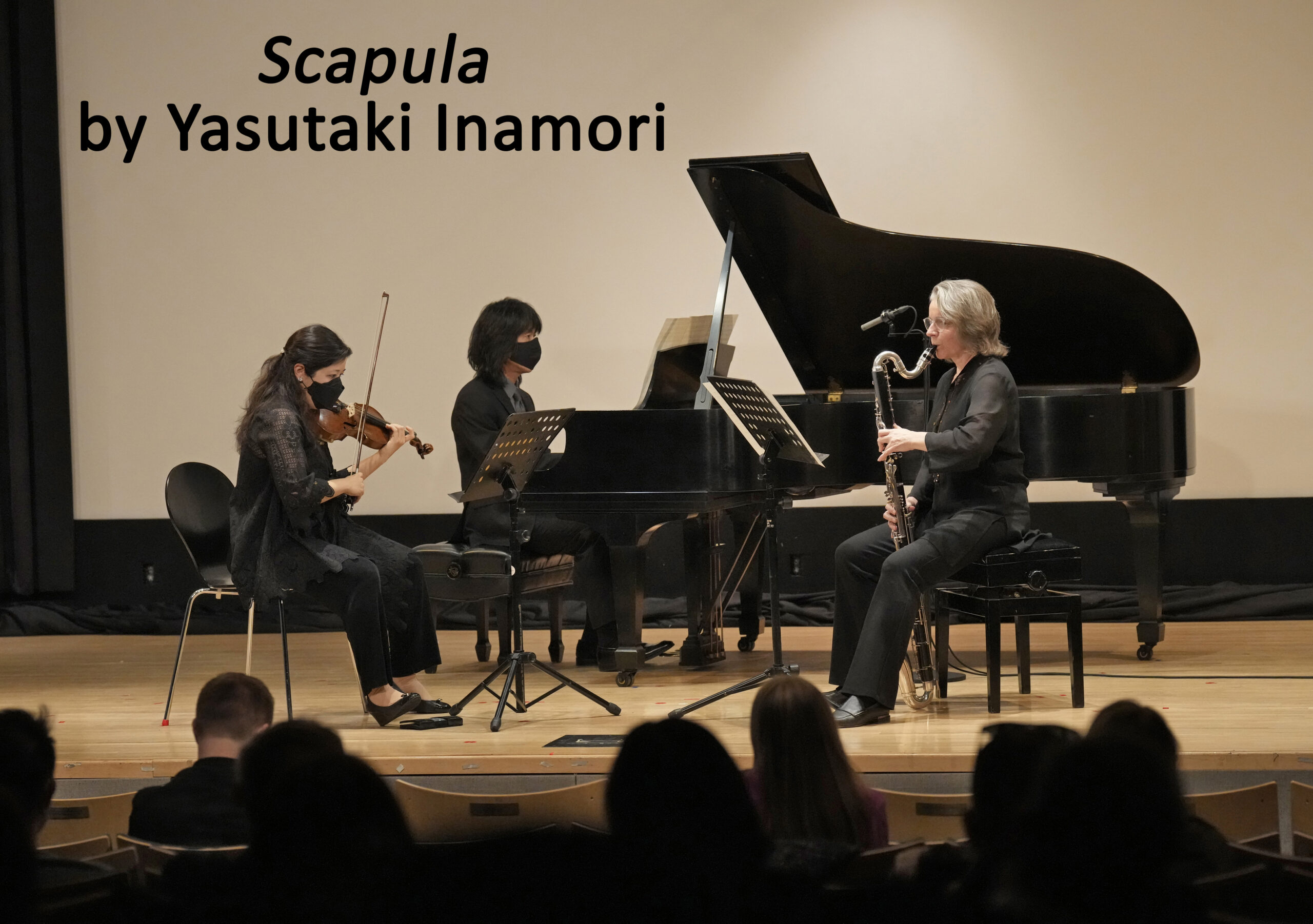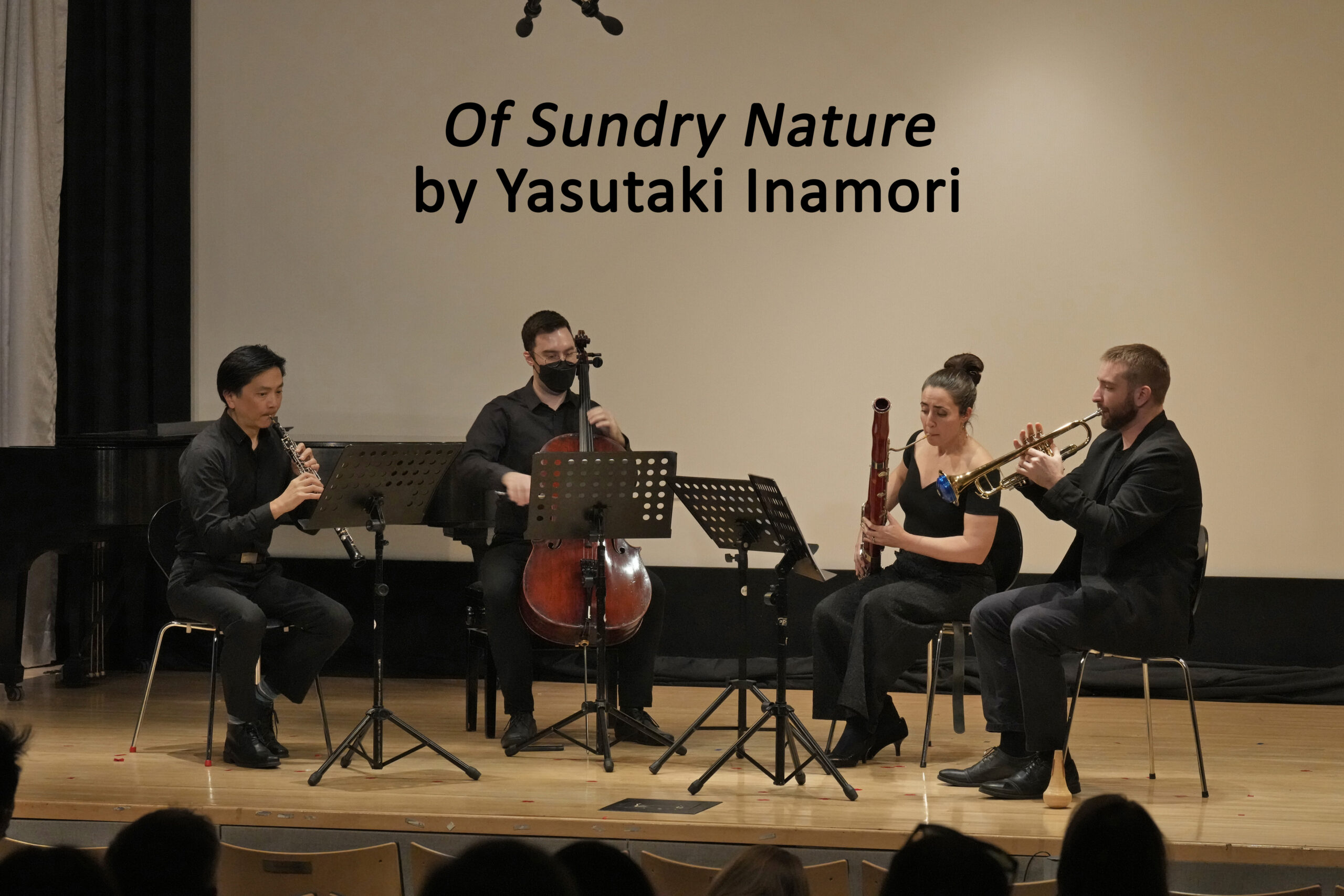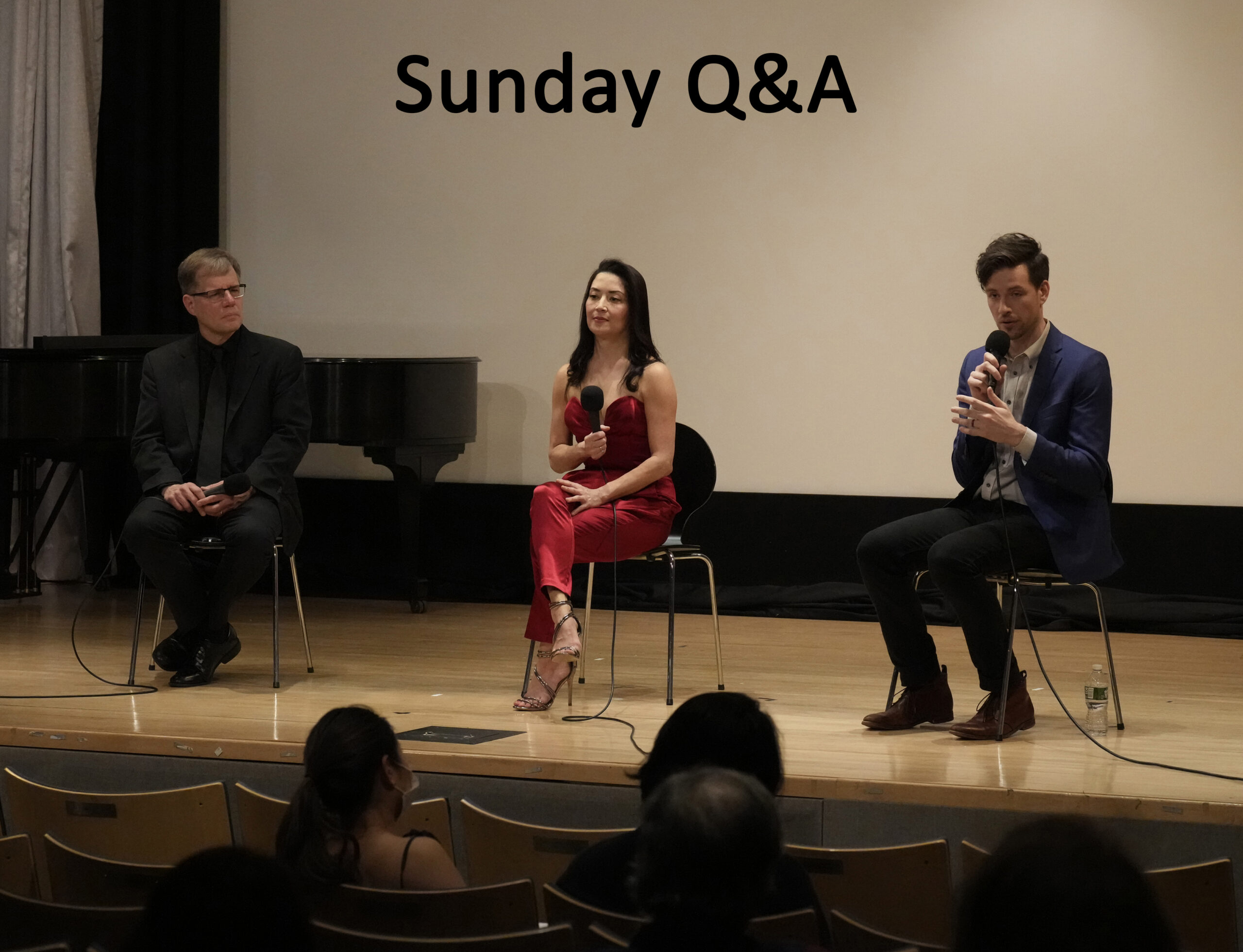
all slideshow photos by Ken Howard
Festival 2022 New York
Saturday, March 5: Current Sounds Japan II
Sunday, March 6: Tomojiro Ikenouchi: His Music & Legacy
Music From Japan Festival 2022 Program
The two concerts comprising Music From Japan’s 47th Anniversary Season, Seventh Artist Residency, and Festival 2022 New York coalesced into a dynamic pairing of the work of three contemporary Japanese composers with that of Tomojiro Ikenouchi and some of his distinguished pupils. The first concert, “Current Sounds Japan II”, took place on Saturday, March 5, and featured recent and newly commissioned works by Yasutaki Inamori, Akiko Ushijima, and Hirofumi Mogi – all of which were either US or World Premieres. The composers drew upon influences ranging from 16th century madrigals to electro-acoustic sound design to the sci-fi writings of Phillip K. Dick to create engaging, deeply personal, work. The pieces were performed admirably by fourteen of New York’s finest contemporary instrumentalists. The second concert, “Tomojiro Ikenouchi: His Music & Legacy”, focused on this central figure in 20th century Japanese music and included pieces by some of his well-known pupils – Toshiro Mayuzumi, Michio Mamiya, and Sadao Bekku. The evening was made particularly moving by the involvement of featured performer and Ikenouchi’s granddaughter, Dr. Kristina Reiko Cooper (cello). Dr. Cooper gave a heartfelt introductory talk on her grandfather and his work before performing, along with John Novacek (piano) and Zac Zinger (shakuhachi), a riveting program of duo and solo works by the aforementioned heroes of Japanese music. Both concerts concluded with a Q&A session, where eminent musical professionals and lay concert goers alike were able to engage in dialogue with the composers (Sat) or the performers (Sun) regarding this beautiful music.
Current Sounds Japan II
On March 5th, “Current Sounds Japan II” commenced the festival with a program featuring pieces by Hirofumi Mogi, Akiko Ushijima and Yasutaki Inamori – each composer chose a piece from their portfolio to present along with one new work, commissioned by MFJ for this concert.
The first piece on the program was Inamori’s Scapula, written for a trio of violin, bass clarinet and piano. Taking its name from another name for the shoulder-blade, the work showcases Inamori’s penchant for polyphony and systematic forethought to composing; Scapula relegates each instrument to its own, distinct, register at the onset, imbuing the polyrhythmic interplay with air and clarity. As the music progresses, the distinct voices slowly begin to mingle more with one another, “analogous to the regular stretching which increases flexibility in the body” (in the composer’s own words). The work concludes with total unification of the instrumental voices in long, clustered, tones that provide a final exhale after much rigorous interplay. Inamori’s commissioned work, Of Sundry Nature, was similarly guided by firm compositional structures, this time drawing on Henry Byrd’s madrigal, Is Love a Boy?. Using the structure and syntax of Byrd’s work as a foundation, Inamori replaced particular components of Byrd’s musical language with his own, more contemporary one, thereby drawing interesting parallels between two works separated by centuries.
The second piece on the program was Akiko Ushijima’s Chatoyant, for classical guitar and electronics (in this case, pre-recorded and played back). Ushijima’s interest in modern, popular music and production techniques was evinced beautifully in this work, performed by MFJ stalwart, Oren Fader. Though it employed language outside the typical purview of pop music, Ushijima employed production techniques more associated with dance and electronic music to great effect. Ushijima’s commissioned work, Swish-Swash Rustle, for flute/bass flute, clarinet, cello and percussion, was entirely acoustic, showcasing her command of instrumental writing – utilizing extended techniques and carefully crafted envelopes of sound to create a work similarly meticulous in its sound world to her electro-acoustic work.
Third on the program was Hirofumi Mogi’s Silence and Illusion, an apt composition for this festival of cultural exchange as it set the words of Soseki Natsume (a Japanese writer who wrote in English) to music for piano and soprano. Wonjung Kim (soprano) and Taka Kigawa (piano) carried Mogi’s setting compellingly, conjuring up Soseki’s yearning for an almost visible, not quite reachable, artistic ideal – a perennial theme for many artists and a salient feeling Mogi hoped to convey in the work. Mogi’s commissioned piece, In Memory of Perky Pat, used Philip K. Dick’s story of a similar name as its inspiration. Centered on themes of attachment/resistance as it pertains to growth and adulthood, the work casts the instruments (horn and string quartet) as characters in the story, whose relationships to each other reflect the character development in the story (ultimately moving towards detachment from one another).
Current Sounds Japan II was concluded by a thought provoking Q&A with Mogi, Ushijima and Inamori. Each composer fielded questions from the audience (of lay people and expert scholars alike), reflecting not only on their work but also their compositional and listening practices.
Tomojiro Ikenouchi: His Music & Legacy
The March 6 concert, “Tomojiro Ikenouchi: His Music & Legacy”, focused on this central figure in 20th century Japanese music and included pieces by some of his well-known pupils – Toshiro Mayuzumi, Michio Mamiya, and Sadao Bekku.
The program was opened by Dr. Kristina Reiko Cooper, who in addition to being a world-class cellist is also Tomojiro Ikenouchi’s granddaughter. As such, Cooper’s introductory talk, titled “My Grandfather, NINI”, struck a deeply personal tone, shedding light on Ikenouchi’s views on beauty, composition, pedagogy, and humor.
The first piece on the program one of Ikenouchi’s, titled Ballade on Ancient Japanese Air for piano and cello – performed by John Novacek and Kristina Reiko Cooper. This work was composed (and revised in 1936) for a pivotal concert in the career of Ikenouchi, one that featured his music exclusively at the Hibiya Public Hall in Tokyo, and cemented him as the master fusionist of French and Japanese approaches to composing music. More specifically, Ballade on Ancient Japanese Air combines the typically French, rhapsodic, approach to narrative with a tonal palette that is distinctively Japanese (in this case pentatonic). It is worth noting, however, that it also harkens to the work of such French composers as Debussy who were inspired by the use of pentatonics in Japan.
Next on the program was Toshiro Mayuzumi’s BUNRAKU – composed in 1960 for a concert celebrating the 30th anniversary of the Ohara Art Museum in Kurashiki and dedicated to Mr. Soichiro Ohara. A work for unaccompanied cello, BUNRAKU drew upon traditional Japanese music via explicit emulation of Japanese instruments (in this case inspired by shamisen and vocal narration) . Kristina Reiko Cooper evoked gravitas and measured storytelling in her approach to the piece, emulating the plectrum of the shamisen and moving through the work without fear of silence. The result, again, was a true fusion of cultures articulated in sound.
The third piece on the program, KIO – written in 1980 by Michio Mamiya – was originally inspired by a poem of Kio Kuroda’s. As the second piece composed as a monody dedicated to Kuroda (the first being Genya for violin and piano), KIO was conceived in response to another duo written for Seizan Sakata and the word-famous Yoyo Ma, in which Yoyo was particularly enamored of the sound of shakuhachi and cello together. For this concert, Kristina Reiko Cooper was joined by Zac Zinger on Shakuhachi, to perform the only work on the program that featured a traditional Japanese instrument. Zinger deftly utilized traditional articulation and phrasing in the context outside that of typical shakuhachi repertoire, and Cooper adjusted equally to situate her cello in this unorthodox duo.
After a brief intermission, John Novacek returned to the stage to perform another work of Ikenouchi’s from 1954, titled Sonatine No. 1. Originally written at the request of pianist Kazuko Yasukawa, this piece showcases Ikenouchi’s dazzling command of French compositional techniques – manipulating, in this case, the developmental characteristics of various conventions – in service of a deeply personal result. Novacek’s touch on the dark-sounding Steinway at Victor Borge Hall was perfectly attuned to the demands of the piece, which he hopes to play on future recitals.
Finally, Cooper joined Novacek for Sadao Bekkus’ Sonate from 1974. Based on a melody the composer had been mulling over for some time, Sonate applies a polyphonic approach to the music while avoiding the typical harmonic movement one might associate with it. As its genesis might suggest, the focus is on the singable melodies sounded by both the piano and the cello. The rapport between Cooper and Novacek was also salient to this performance – the two artists. have been working together for many years
After the concert, the three performers (Cooper, Novacek and Zinger) graciously engaged in a Q&A with the audience. Each artist fielded questions about various topics, including the concert’s repertoire, cultural symbols within music drawing from more than one tradition (such as the work of Ikenouchi and his pupils), and the work of other students of Ikenouchi who were not selected to be featured on this program.
Music From Japan also presented a similar program in a single event in Tokyo, on May 29th, 2022.














